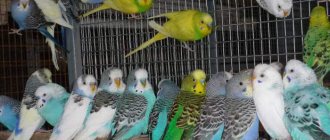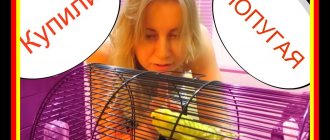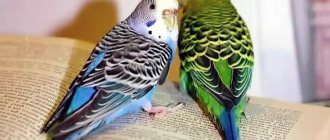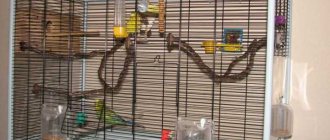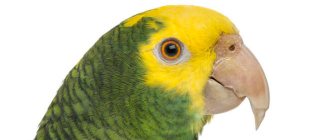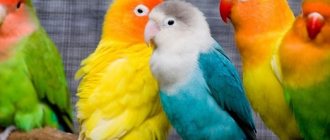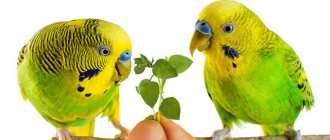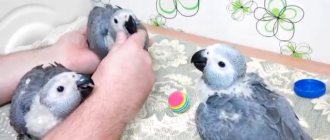Many people keep budgies at home - their care is minimal, but the emotional return is enormous. Before buying, the future owner thinks about how to choose the best budgie: healthy, young, and able to talk. After reading the article, you will learn about all the subtleties: what questions to solve initially, what places sell good birds, what a budgie should look like. And the last thing is what you need to do when you take your baby home, how to help him survive the adaptation.
What to consider before buying a parrot
Buying wavy should not be a surprise to family members. To ensure that the bird is surrounded by love and care, discuss with your loved ones all the issues related to the acquisition of a wavy bird.
- Pet lovers often refuse to buy pets due to allergies to wool, down and feathers. If one of your family members has an allergic reaction to birds, you should not get a parrot.
- Take into account the behavior of your budgerigar. The bird loves to talk and sometimes makes a lot of noise. An active wavy can encroach on wallpaper and cornices, causing damage to the apartment. The pet needs space to fly; the parrot will wither away in a cramped cage, so it needs to be released.
- Decide on the sex of the parrot. When deciding to purchase a boy or girl budgie, learn about the personalities of the males and females. Boys are active, talkative and friendly, while girls are more shy.
- When purchasing a parrot, you need to know that you will have to keep your pet for a long time. Some birds live up to 18 years. Wavys are talkative, so the bird requires daily communication and training.
Armed with knowledge about budgerigars and having gathered a family council, you can go for a pet.
Indicators of a healthy bird
Whatever parrot you choose, the main thing is that it is healthy. But a boy or a girl, a chick or an adult is not so important. We are not talking now about those people whose main feature is volunteering.
Choosing a healthy parrot
They welcome everyone: a sick cat, a lame dog, a crow with a broken wing, an old hedgehog who wandered into the countryside in search of food... Exotic birds are no exception.
An ordinary person cannot withstand such stress. Treating animals is very difficult, expensive, and requires enormous emotional investment. It's okay to choose healthy ones. What to look for when choosing?
Beautiful plumage
Turquoise, white, yellow, green birds with wavy dark stripes on the back, wings and neck (for which they got their name) should be shiny, bright, with feathers tightly fitting to the body.
Clean nostrils and beak
Neither on the beak nor on the cere of a healthy young bird there is peeling, separation, or even discharge.
One of the indicators of a healthy parrot is clean nostrils and beak
Quiet breathing
No overtones, and even breathing itself should not be heard. You can feel it by holding the wavy in your hands.
Proportional beak
The nose is straight, exactly in the center, the wax is located symmetrically.
Number of fingers
Be sure to check your paws! Injured limbs in these birds may not just hurt. The damaged finger may dry out and die (fall off). No growths, abrasions or bruises. The limbs are even in color, covered with feathers, tenacious.
Clean cesspool
Carefully examine the tail and what is underneath it. If your parrot has gastrointestinal problems, it will be noticeable. Sometimes the anus is occupied by scabies mites. It is advisable to detect the presence of parasites or insects before purchasing.
Check the cleanliness of the cloaca
Sociable behavior
The wavy is a mobile creature. If he is apathetic, looks sleepy, or is offended by his relatives, it is better to take another one. But not the one that rushes around the cage like a madman, bumping into objects. These are the first signs of ill health. The bird should be cheerful, all its movements should be coordinated.
Read also
What time does a budgie go to bed?
Where to buy a budgie
An important factor when buying a bird is choosing a responsible seller who guarantees the health of the budgie. Currently the following options exist:
- Pet Shop
- Breeders
- Bird Market
Professional breeders are rightfully considered the most reliable seller. They provide the buyer with reliable information about parrots and help determine the sex of the bird in the early stages. As a nice bonus, you can look at the parents of the selected individual. This is especially true if you decide to purchase a chick. By observing the parents of a budgerigar, you can learn about the pet’s character and its plumage in the future.
When buying a budgie in a pet store, you risk encountering an incompetent seller. Unfortunately, the main goal of store employees is to increase sales. Therefore, sellers try to sell chicks by all means, sometimes deliberately determining the wrong gender of the wavy.
The last thing you should think about is going to the poultry market. At the market, parrots are kept in unsanitary conditions and often get sick.
Determining gender by behavior
Plumage color and other external characteristics help determine gender if you study the specific variety well. By behavior, you can distinguish a male from a female bird of any breed. So, girls are usually calmer, like to nap, relax, and it is difficult to interest them in a mirror, bell and other toys. They do not like to sit on hands, they get irritated when the owner tries to pet or scratch them, and they can bite the owner’s finger until it bleeds. Ladies do not respond to human conversation, are poorly trained and are considered more wild and aggressive. In nature, females hollow out hollows in which they raise chicks, so their genes contain a constant desire to gnaw on something, for example, a cage or a perch.
Boys are usually more good-natured by nature. They easily get used to being handled, love to play, chirp, and they like to communicate with their reflection in the mirror. Males respond well to human voices and always prefer to carry on a conversation. If the look is speaking, then the guy will begin to repeat words faster than his partner. These are friendly, tame animals that happily sit in their owner’s arms.
You can tell the difference between a boy and a girl by observing the behavior of the couple. Males often place their paw on their cagemate. If a boy and a girl are kept together, the boy will feed his girlfriend by regurgitating food into her beak. During sexual intercourse, boys are always on top and girls are on bottom. Often in the behavior of the male one can observe an imitation of sexual intercourse with other objects. Some ladies also exhibit similar behavior, but not so often
In most species, during the mating season, it is the male who tries to attract the attention of his beloved. He dances, demonstrates the beauty of his plumage and his vocal abilities
You can determine the sex of a feathered pet by its sitting style. For example, girls sit on a perch with their paws widely spaced, as if placing their belly on the perch. Boys usually move their paws tightly together when sitting. This sign can be observed when the parrot reaches one year of age.
How to choose a healthy parrot
In order for a parrot to live a long life and delight its owner with its funny habits, you must first purchase a healthy bird. Treatment of budgerigar diseases requires the intervention of ornithologists, which will lead to large expenses. When choosing a budgie, pay attention to the signs of a healthy bird:
- Shiny clean beak.
- The thickening at the base of the beak, or cere, should be smooth. Roughness and growths may indicate health problems.
- Smooth shiny plumage. The feathers of a healthy parrot fit tightly together.
- Lively look and sparkle in the eyes.
- Clean nostrils. It is dangerous to buy a bird whose nostrils are clogged with secretions.
- Active confident movements. A healthy bird does not sit with all its feathers, but is interested in the world around it.
- A toned abdomen and chest that do not stand out from the body.
If the parrot is unkempt and alienated from its relatives, this indicates a problem. Parrots offend a sick bird and do not accept it into their community. Growths on the paws and cere, as well as dirty feathers and cloaca, also serve as a dangerous signal.
How to determine the sex of rosella, necklace, and gray parrots
Parrots of the genus Gray, Rosella and necklace representatives are also chosen for home keeping. These birds have characteristic appearance features that can be used to determine their gender.
The main differences between females and males:
- By the age of 2-3 years, male parrots with necklaces develop a black rim around their necks, resembling a necklace. Girls do not have such decoration.
- Male African Gray parrots have a large body, a small flat head and a short neck. Girls are slimmer, have a rounded head, and a long neck. Males have a more uniform and darker color. Females have gray belly feathers.
- Boys of the genus Rosella have a sloping nape and a massive beak at the base. Females have a round head and light stripes on the inside of their wings.
The most accurate answer to determining the sex of a parrot will be shown by a DNA test. The study is carried out in laboratory conditions. The owner must provide a plucked feather for analysis (feathers that fall out are not suitable for testing). Such an analysis is quite expensive, but it shows a 100% reliable result.
Regardless of gender, parrots in the house need to be provided with comfortable conditions and a healthy diet for health and longevity. In our store you can buy high-quality food for different types of parrots, healthy supplements with vitamin and mineral complexes, cozy cages for birds to live in, feeders, drinkers, perches, various toys and other accessories for a comfortable and healthy life for your feathered friend!
Signs of a young budgie
When purchasing a budgie, you need to give preference to a young individual. Adults have fully formed characters and are difficult to train. A young parrot quickly gets used to its surroundings and feels comfortable.
What should you rely on when choosing a young bird? To determine the age of a wavy, pay attention to the following signs:
- The beak and eyes are black. Adults have irises and a light border around the eyes.
- The younger the parrot, the shorter its tail. The tail feathers grow to their maximum when the parrot reaches two months of age.
- The bright, rich color of feathers is characteristic of adult parrots.
- The young bird has a clear pattern on its head and back. As we age, the lines become blurred.
By carefully examining the bird, you can determine its age with high accuracy. The main thing is to know the nuances of selection and carefully examine the parrot.
How to help a bird adapt
So, the budgie was selected, purchased and delivered to the apartment inside a carrier. Now you need to carefully move it into the prepared cage. To do this, place the portable box next to the cage and align both open doors. It is necessary to pay attention: you cannot catch the bird and move it to a permanent home. Don't let him fly freely around the room. Be patient, otherwise the frightened bird will not be able to trust you for a long time.
Upon entering the cage, the parrot will discover the amenities you have created: feeders, various climbing devices, and seats. At first, he will hide from prying eyes in containers. Place a grain mixture and fresh twigs in the feeders in advance so that a hungry baby has something to do.
For the first two weeks, do not walk your new pet, do not disturb him again, and clean up the cage less often. Let the chick get used to the environment, new sounds and objects, and people's voices. Do not allow pets into the room, protect the parrot from flashes of light, create a suitable microclimate. Address the wavy kindly, call him by name.
Noticing that your ward is showing friendliness, let him out for a walk. Before doing this, secure the room as much as possible, close the doors and windows. Normally, the adaptation period ends when the bird calmly sits on the shoulder or finger of its owner. After this, consider that contact has been established.
Choosing a budgie is an important and difficult task. With proper care, a small feathered pet will live with you for ten years or even more. Decide in advance how many birds you need, what gender and age. Go to a reputable breeder to ensure you get healthy parrots.
How much to buy and what gender
The answer to the question of how many birds to buy directly depends on the capabilities and preferences of the owners. If you bought a small cage in advance, in which there is no room for a large group of birds, you should not try to put a whole family of parrots in it.
In their native Australia, birds live in flocks and form mating pairs, remaining faithful to their partner throughout their lives. In the company of its fellows, the parrot does not need to communicate with humans. The lonely bird will eventually get used to human society and become a full member of the family. However, for this, the parrot must constantly be in contact with people. If the owner is rarely at home, the pet needs to find suitable company.
To determine the sex of your pet, you need to know about the behavioral characteristics of males and females. Girls are more aggressive and slow to learn to speak, while boys quickly learn new sounds and words.
He or she
Male
The boy is a very active pet
He will make noise, shout, in general, attract attention to himself in all the ways known to him. At the same time, the boy is very talented
He can imitate almost any sound, so he will delight you with interesting trills, songs and sounds all day long.
If you buy only one boy, you can quickly teach him human speech (in the case of regular lessons). However, a lonely male becomes very attached to his owner and gets very bored in his absence. It's best to find a pair for him. And it doesn’t have to be a girl, it can also be a boy – males get along well.
Female
The female budgerigar will be calm and relatively quiet. A girl does not achieve the same ability in imitation as a boy, so her songs are rare and short.
The girl would rather restore order than start screaming loudly and for a long time. If you decide to have a mate for a female, it is better to choose a boy. The female can start quarrels with a same-sex bird.
Rules for sharing
In order for the acquaintance of parrots to pass without any incidents, you need to follow some rules. Remember that a female is being placed with a male. Otherwise, the female will attack the new resident, defending her territory. If they are looking for a couple for a girl, then it is better to purchase a new, spacious cage, where the boy should be placed first.
To avoid unnecessary quarrels or fights between parrots, the cage must be prepared in advance - hang additional perches, another drinking bowl, bathing bowl, and feeder.
Don't forget about quarantine - a new pet must be kept separately for forty days to identify possible hidden diseases. During this period, you can “make friends” with a new parrot. When he is in a couple, it is more difficult to do this.
How to choose a boy's budgie
If you want to purchase a male budgerigar, you need to carefully choose a seller. It is better to buy from breeders who can determine the sex of the chick in the early stages. When buying a pet at a pet store, you need to rely on your own knowledge. The male wavy has the following characteristics:
- The young male has a light purple or pink cere. With age, the color of the formation changes and varies from blue to purple throughout the day.
- The young male does not have light circles around his nostrils, unlike the females.
- The paws have a bluish tint.
- Wide head with a flat crown.
Determining the sex of a parrot is a difficult process, especially if you are looking for a young boy. But with the help of the seller and your own knowledge, this task is not difficult to cope with.
What should the nest be like?
Budgerigars willingly hatch eggs in wooden boxes. Vertical nesting boxes have a base of 17x17 cm and a height of 23-25 cm. Horizontal nesting boxes have a base of 17x23 cm and a height of 17 cm. The hole usually has a diameter of 5 cm. There are cases when females artificially expand it by gnawing on the edges.
Outside, under the hole, a perch or twig is attached so that the male can feed the female and protect his nest from uninvited guests. Some owners make nesting boxes for their pets themselves. The nest box for breeding budgies should be similar to a birdhouse and have a rectangular shape.
Approximate dimensions: height – 17 cm, length – 23 cm and width – 17 cm.
Untreated softwood is very suitable for nesting. A small round depression 2 cm deep and 10 cm in diameter is made in the floor with a milling cutter so that the eggs from the clutch do not roll out in different directions. The lid of the box should be removable for ease of cleaning and disinfection. Sawdust mixed with chamomile powder is poured onto the bottom of the nest.
Once a week after the chicks hatch, a general cleaning of the nest is done. Thanks to the thick walls and floor, the nesting box retains moisture and heat well, and, consequently, the chicks develop better and fewer eggs die.
Plastic nesting boxes are available for sale. They are, of course, convenient to clean, but they will not retain moisture and heat as well as wood.
In most cases, successful nesting depends on the physical condition of the pair. The male should be young, energetic, during this period he should have a bright blue cere, and the female should have a brown color.
How to buy talking wavy buying
A parrot's ability to reproduce sounds and words depends entirely on the pet's owner. Of course, the natural characteristics of the parrot play a significant role. It has been proven that males learn faster and can pronounce complex verbal structures. Some females can produce good results after skillful training.
In order to willingly talk to a person, the wavy must have good health. If you want to buy a talking budgie, you need to pay attention to the appearance of the bird and its activity. A healthy parrot is always in a good mood and strives to reproduce the sounds it hears. It is noteworthy that the weakest individuals become more attached to a person, which makes training more effective.
In order for a parrot to learn to speak, it is necessary to communicate with the bird daily, pronouncing words calmly. Affectionate intonation will strengthen your relationship with your pet and contribute to rapid learning.
How to teach to talk
It is clear that if you do not work with the wavy, he himself will never learn to imitate human speech. You need to learn conversation from an early age, but not immediately after purchase. Be sure to give the bird time to adapt. Depending on the nature of the bird, this could be a week, two or even three. In any case, there is no need to rush.
You need to start teaching your parrot words only after he gets used to you - he will not run deeper into the cage when you approach, he will boldly sit on your finger, take food from your hands, etc. Initially, you need to teach the simplest and shortest words that need to be repeated regularly when performing some action. For example, when pouring food, you can say “Eat”, changing the water - “Water” or “Drink”, etc. If you want to teach your parrot long phrases, record them on a voice recorder and play them back to your parrot.
It is important that it is better to do this in the twilight, because if the bird sees poorly, they begin to concentrate on sounds. It has been noticed that budgies perceive high-pitched voices better, for example, women's voices.
Now you know how to choose a parrot for your home so that it can start talking. It's not as difficult as it might seem at first glance.
Which parrot should you not take?
In a pet store, customers are often blindsided by the abundance of colors of wavy plumage. However, the beauty of the bird does not play the most important role, although some features of the parrot’s appearance may indicate health problems. When purchasing a budgie, it is important to pay attention to the following details:
- Growths on the cere and paws;
- Dirty feathers and cloaca;
- The bird sits, ruffled, and is alienated from the rest of the birds;
- The parrot jumps nervously around the cage;
- The bird's nostrils are clogged with secretions.
You should not buy a wavy pet that has at least one of the above signs. By purchasing a sick bird, you risk encountering diseases, the treatment of which will require large expenses.
Photo gallery
Photo 1. Variegated light blue parrot
Photo 2. Cage for a parrot with a toy
Photo 3. Light blue and green budgie
Photo 4. Open bird cage
Photo 5. Interesting shot with a parrot
Photo 6. Light green budgerigar
What to do after purchase
It may take some time for your parrot to adapt to new conditions. Pre-prepare a spacious cage for the parrot by equipping the bird’s home with a convenient drinker and feeder. Buy suitable food after consulting with the seller. Unusual food can cause damage to the wavy's stomach. At first, the parrot tries to hide from prying eyes by climbing into a feeder or drinking bowl. Make sure that the drinking bowl is not closed.
When transferring a budgie to a new home, you should not let the bird into the room. In an unfamiliar environment, she will rush from corner to corner or fly out of an open window. Don't frighten the new tenant with loud noises and bright lights. The first weeks of the wavy's stay are an important period that establishes relationships between the pet and family members.
Choosing a pair for a show parrot
If you plan to show birds at exhibitions, as well as breed them, then some features are taken into account:
- as with ordinary parrots, a quarantine and adaptation period are required;
- even if a new individual is purchased from a breeder from home, you still need to leave the bird in a separate cage for about one month to avoid the transmission of infectious diseases;
- so that the birds do not harm each other at the first contact, they must get used to it, so they are kept in the same room, but in different cages for about 2 weeks, after which they can be released for joint walks around the room;
- if the male and female do not experience aggression, and also try to communicate through the cage, they can be placed in one cage, which should be spacious;
- to prevent conflicts, feeders and drinkers are located in different parts of the cage;
- To quickly get used to exhibition parrots, it is recommended to remove toys and mirrors for the first time, as the birds will begin to pay a lot of attention to each other;
- it is recommended to place a female with the male, otherwise the girl may show aggression, as she will defend her territory, which will lead to conflicts and fights;
- after moving in, you need to monitor the behavior of the birds, not leaving them unattended, since strong fights can lead to damage to the eyes, wings or legs of show parrots.
If you plan to breed birds, then genetic lines are followed to produce healthy offspring, so individuals must match each other in color, size and character.
Way out
At the family council, they decided not to change the name (the bird was already accustomed to it), to buy a second individual, now definitely male. True, from the same book we read that only a single bird can be taught to speak. If there are two or more of them, good luck! They will chirp among themselves and not pay any attention to the teacher. The bird then begins to speak when it perceives people as its flock.
But at this stage, this fact was no longer important to us, we had something else in mind - to try to breed chicks, one of which must then be taught to speak. And we succeeded! But this is a completely different story.
The torment of the unknown
We stared at Kesha, trying with all our might to determine the color of his wax. It was a completely incomprehensible color: pale lilac-grayish. Luckily for us, we didn’t see any distinct white spots around the nostrils! There was nothing to do but wait.
Photo: Depositphotos
Every day we looked with alarm at the hated wax, hoping that it was about to begin to turn blue and turn blue. But it was not there. The color began to brown and eventually turned brown. Our Kesha turned out to be a girl!
Talking bird
Budgerigars are not the most talkative birds. Jaco or Ara begin to speak better and faster. However, if desired and with the right approach, you can “talk” to the wavy one. Young males train best and are the ones you should pay attention to when purchasing. It is a common belief that birds kept in pairs will not speak. However, this is not quite true. The result largely depends on the innate abilities of the bird and the effort spent on training.
Advice. Parrots are flocking birds and feel sad when left alone. First, you can buy one parrot and, after teaching it to talk, buy it a pair. In this case, he will not lose the acquired skills and will not be so lonely.
